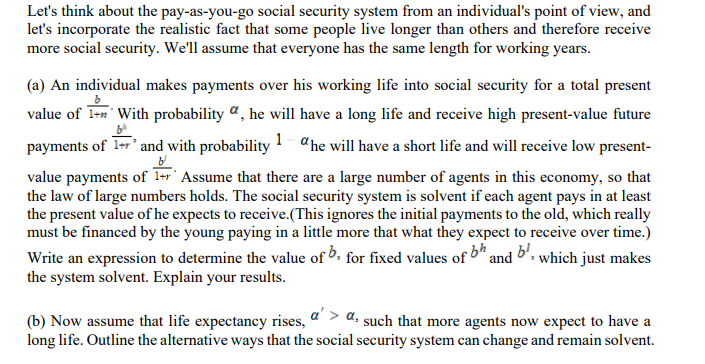
Let's think about the pay-as-you-go social security system from an individual's point of view, and let's incorporate the realistic fact that some people live longer than others and therefore receive more social security. We'll assume that everyone has the same length for working years. (a) An individual makes payments over his working life into social security for a total present value of 1+nb. With probability , he will have a long life and receive high present-value future payments of 1+rbb, and with probability 1hewillhaveashortlifeandwillreceivelowpresent- value payments of 1+rbj. Assume that there are a large number of agents in this economy, so that the law of large numbers holds. The social security system is solvent if each agent pays in at least the present value of he expects to receive.(This ignores the initial payments to the old, which really must be financed by the young paying in a little more that what they expect to receive over time.) Write an expression to determine the value of b, for fixed values of bh and bl, which just makes the system solvent. Explain your results. (b) Now assume that life expectancy rises, >, such that more agents now expect to have a long life. Outline the alternative ways that the social security system can change and remain solvent. Let's think about the pay-as-you-go social security system from an individual's point of view, and let's incorporate the realistic fact that some people live longer than others and therefore receive more social security. We'll assume that everyone has the same length for working years. (a) An individual makes payments over his working life into social security for a total present value of 1+nb. With probability , he will have a long life and receive high present-value future payments of 1+rbb, and with probability 1hewillhaveashortlifeandwillreceivelowpresent- value payments of 1+rbj. Assume that there are a large number of agents in this economy, so that the law of large numbers holds. The social security system is solvent if each agent pays in at least the present value of he expects to receive.(This ignores the initial payments to the old, which really must be financed by the young paying in a little more that what they expect to receive over time.) Write an expression to determine the value of b, for fixed values of bh and bl, which just makes the system solvent. Explain your results. (b) Now assume that life expectancy rises, >, such that more agents now expect to have a long life. Outline the alternative ways that the social security system can change and remain solvent







